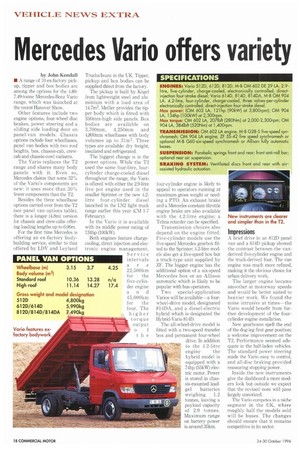Mercedes Vario offers variety
Page 20

If you've noticed an error in this article please click here to report it so we can fix it.
by John Kendall • A range of 10 ex-factory pickup, tipper and box bodies are among the options for the 4.807.49-tonne Mercedes-Benz Vario range, which was launched at the recent Hanover Show.
Other features include two engine options, four-wheel disc brakes, power steering and a sliding side loading door on panel-van models. Chassis options include four wheelbases, panel van bodies with two roof heights, bus, chassis-cab, crew cab and chassis-cowl variants.
The Vario replaces the T2 range and shares many body panels with it. Even so, Mercedes claims that some 32% of the Vario's components are new: it uses more than 30% fewer components than then.
Besides the three wheelbase options carried over from the 72 (see panel van options table), there is a longer (4.8m) version for chassis and crew-cabs offering loading lengths up to 6.06m.
For the first time Mercedes is offering an ex-factory bodybuilding service, similar to that offered by LDV and Leyland Trucks/Isuzu in the UK. Tipper, pickup and box bodies can be supplied direct from the factory.
The pickup is built by KOgel from lightweight steel and aluminium with a load area of 14.7m2. Meiller provides the tipper body which is fitted with 350mm-high side panels. Box bodies are available on 3,700min, 4,250mm and 4,800mm wheelbases with body volumes up to 31m3. Three types are available: dry freight, insulated and refrigerated.
The biggest change is in the power options. While the T2 used the same four-litre, fourcylinder charge-cooled diesel throughout the range, the Vario is offered with either the 2.9-litre five pot engine used in the smaller Sprinter or the new 4.2litre four-cylinder diesel launched in the LN2 light truck range earlier this year (CM 1-7 February).
In the Vario it is available with its middle power rating of 134hp (100kW).
Both engines feature chargecooling, direct injection and electronic engine management. Service intervals a r e 22,500km 3.7 4.25 for the five-cylinder engine and 45,000km for the four. The higher torque output
o f the
four-cylinder engine is likely to appeal to operators running at maximum gross weight or needing a PTO. An exhaust brake and a Mercedes constant-throttle engine brake are also available with the 4.2-litre engine; a Telma retarder can be specified.
Transmission choices also depend on the engine fitted. Five-cylinder models use the five-speed Mercedes gearbox fitted to the Sprinter; 4.2-litre models also get a five-speed box but a truck-type unit supplied by ZF. The bigger engine has the additional option of a six-speed Mercedes box or an Allison automatic which is likely to be popular with bus operators.
Two special-application Varios will be available—a fourwheel-drive model, designated 814DA, and a diesel-electric hybrid which is designated the Hybrid-Vario 814D.
The all-wheel-drive model is fitted with a two-speed transfer box and permanent four-wheel drive. In addition to the 4.2-litre
engine the hybrid model is equipped with a 74hp (55kW) electric motor. Power 4 is stored in chassis-mounted lead
gel batteries weighing 1.2 tonnes, leaving a payload capacity of 2.9 tonnes. Maximum range on battery power is around 35km. A brief drive in an 812D panel van and a 614D pickup showed the contrast between the vanderived five-cylinder engine and the truck-derived four. The van engine was much more refined, making it the obvious choice for urban delivery work.
The larger engine became smoother at motorway speeds and would be better suited to heavier work. We found the noise intrusive at times—the Vario would benefit from further development of the fourcylinder engine installation.
New gearboxes spell the end of the dog-leg first gear position; a welcome improvement on the 12. Performance seemed adequate in the half-laden vehicles. The standard power steering made the Vario easy to control, and all-disc braking provided reassuring stopping power.
Inside the new instruments give the dashboard a more modern look but outside we expect that the revised nose will pass largely unnoticed.
The Vario competes in a niche segment in the UK, where roughly half the models sold will be buses. The changes should ensure that it remains competitive in its sector.




















































































































